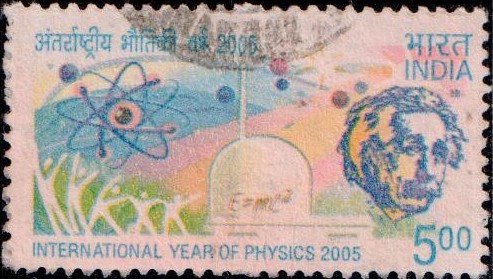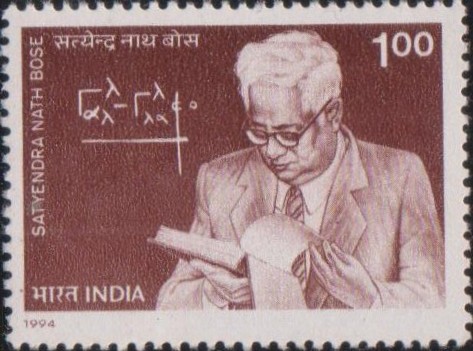
India on International Year of Physics 2005
A definitive postage stamp on the Centenary of Special Theory of Relativity, Photoelectric Effect and Brownian Motion – publications done by Albert Einstein :
 Issued by India
Issued by India
Issued on Mar 31, 2005
Issued for : Department of Posts is happy to issue a definitive stamp on International Year of Physics under the 9th Definitive Series.
Credit :
Stamp & FDC : Kamleshwar Singh
Cancellation : Alka sharma
Type : Stamp, Postal Used
Colour : Multi Colour
Denomination : 500 Paise
Printing Process : Photogravure
Printer : India Security Press, Nashik
About :
- The year 1905 marked a turning point in Physics with the publication of five papers on three major subjects by Albert Einstein, Special Theory of Relativity, Photoelectric Effect and Brownian Motion. These papers, published a century ago, changed our fundamental understanding of nature so much that 1905 is often referred to as the ‘Miracle Year’. In celebration of the centenary of these papers the year 2005 has been declared as the World or International Year of Physics.
- Special Theory of Relativity: Newton’s laws state that the velocity of light must change when someone moves while according to the theory of the origin of light (called electromagnetic theory) it should remain constant. Einstein assumed that the velocity of light was fundamental and could not be changed. He worked out how Newton’s laws must be changed to fit this basic fact. He showed that when objects move at a speed close to the speed of light (c), they behave very differently. Since the velocity of light is very large (about 3 lakh km per second), in our daily experiences, the difference is not noticeable. Einstein showed that if you move at velocities close to velocity of light, time appears to move slowly and distances appear to shrink. As one approaches the velocity of light, the extra energy given to increase its momentum (mass x velocity) does not increase its velocity, but increases its mass (inertia). This leads to the famous equation describing the relation between energy and mass, E = mc2, where E is energy, m is the mass and c is the speed of light in free space (vacuum). This theory is critical to the working of a lot of physics at very high energy. This explains, for example why a moving clock appears to go slower than a stationary clock. Eleven years later, Einstein generalised this work into an even more profound theory called General Theory of Relativity. These physical laws are critical to the working of satellites used in navigation. It also explains why Newton’s theory cannot fully explain the path of planets around the Sun or why the light coming from stars is bent from its path when it comes close to the Sun.
- Photoelectric Effect: In this Nobel Prize winning work, Einstein studied how light can eject electrons from material. He showed that this can be understood only if we assume that light comes in small packets called photons. He showed that for photons to eject electrons from a material, they must have energy proportional to their frequency. Hence, even a large number of low energy photons will not eject electrons but a single high energy photon can eject an electron. This theory correctly explained the photoelectric effect. It also laid the basis for the Quantum Theory which revolutionised our understanding of nature. This physics is now routinely used in laser and several other applications like solar cells.
- Brownian Motion: This was the third subject that Einstein tackled in 1905. When he did this work, there was a lot of confusion about the nature of matter in the smallest scale. He investigated the observations of restless movement of pollen particles in water which had been first noted by a botanist Robert Brown. Einstein showed that this movement can be understood only as a continuous collision between water molecules and the pollens. It conclusively established that material is made of molecules and atoms. The theory of Brownian Motion is now routinely used to understand natural processes including the manner in which liquid and solid particles mix with each other. Understanding Brownian Motion is vital to everything from cell function to traffic flow, from models of ecologies to stock market.
- These three great pieces of work radically changed our views about the working of Nature. Together they established the existence of atoms, of photons as packets of energy and proved that Newton’s mechanics is only an approximation on the working of Nature. If we increase the energy of particles to the extent that they begin to move at velocities closer to the velocity of light, the Newton’s laws change so much that matter and energy become synonymous. The total effect of these pieces of work subsequently led to the quantum theory that explained how matter is stable. They also led to other great works of S Chandrasekhar who established the existence of Neutron Stars and Black holes. It also led S.N. Bose and Einstein to develop the Bose Einstein Statistics that fundamentally altered our view on how atoms interact with each other.
- In one single year i.e. 1905, Einstein changed our understanding of the fundamental laws of nature completely and even a hundred years later, we are still striving to grasp all the deep meanings of his work.
- Text : Based on the material provided by the proponent.
Subscribe
Login
0 Comments
Oldest







